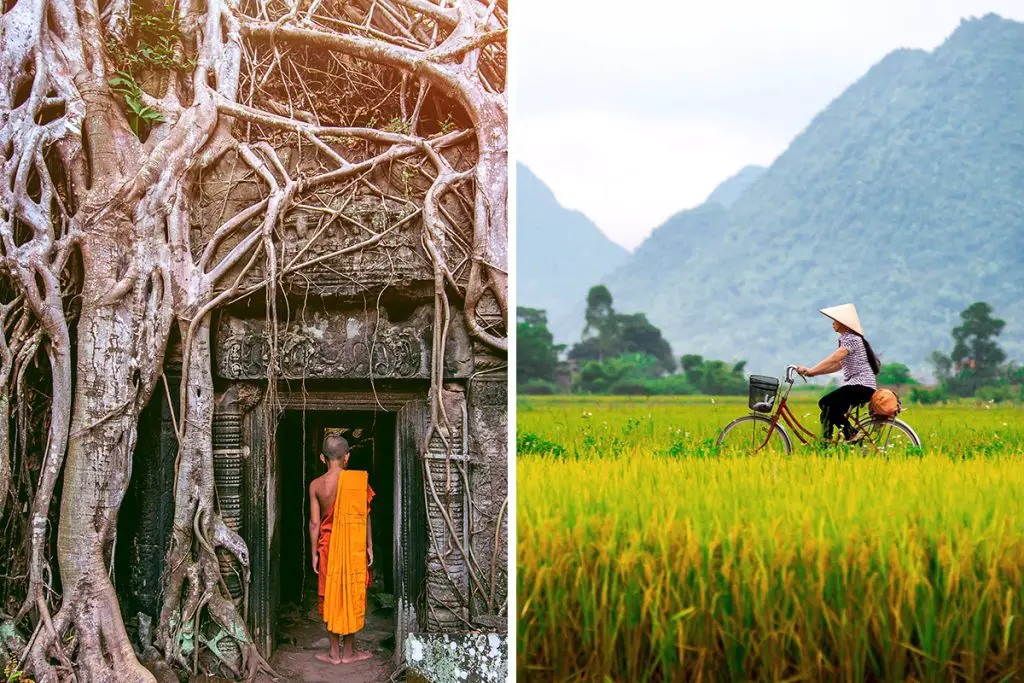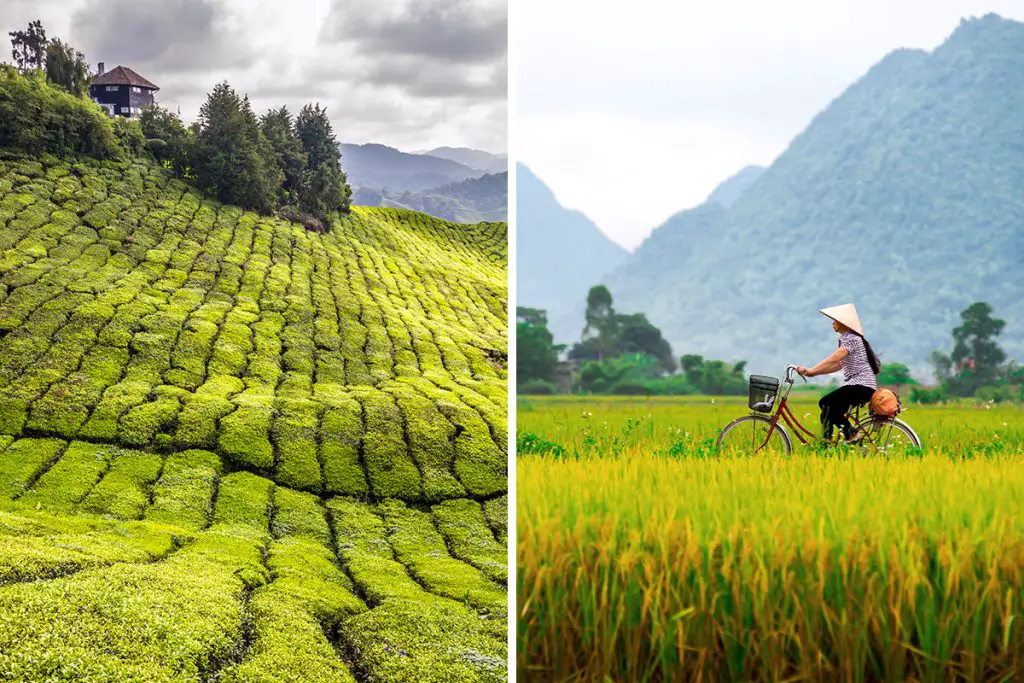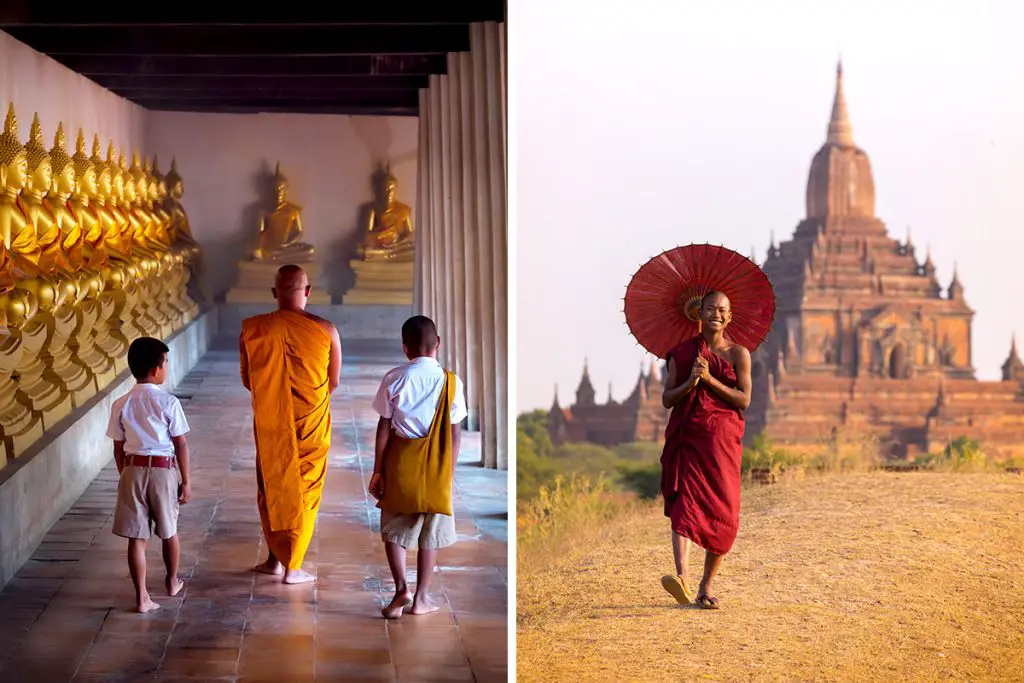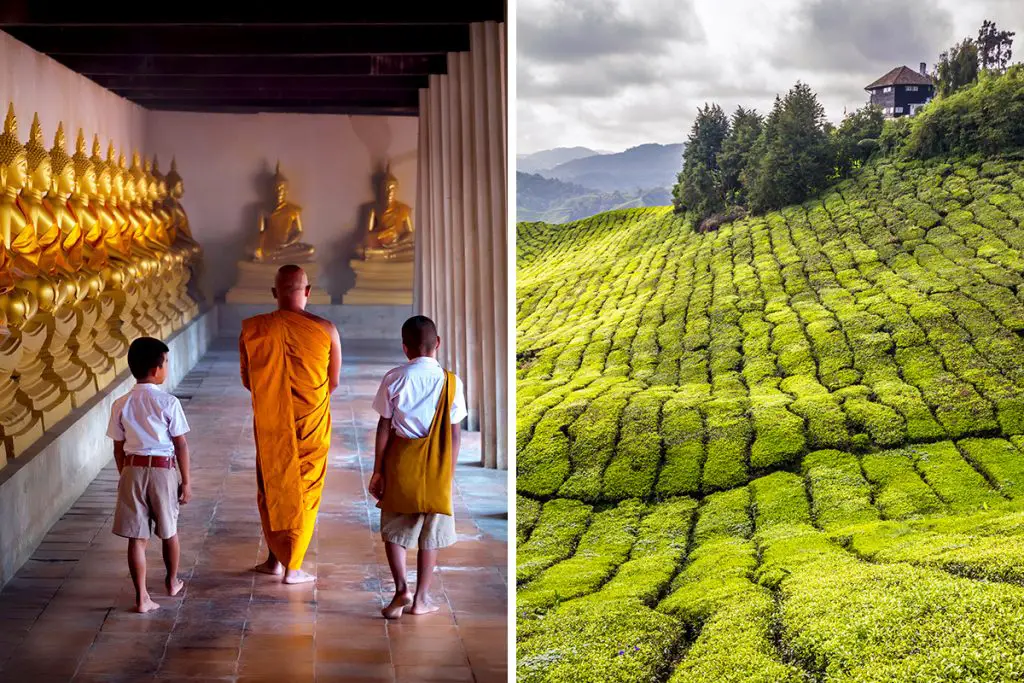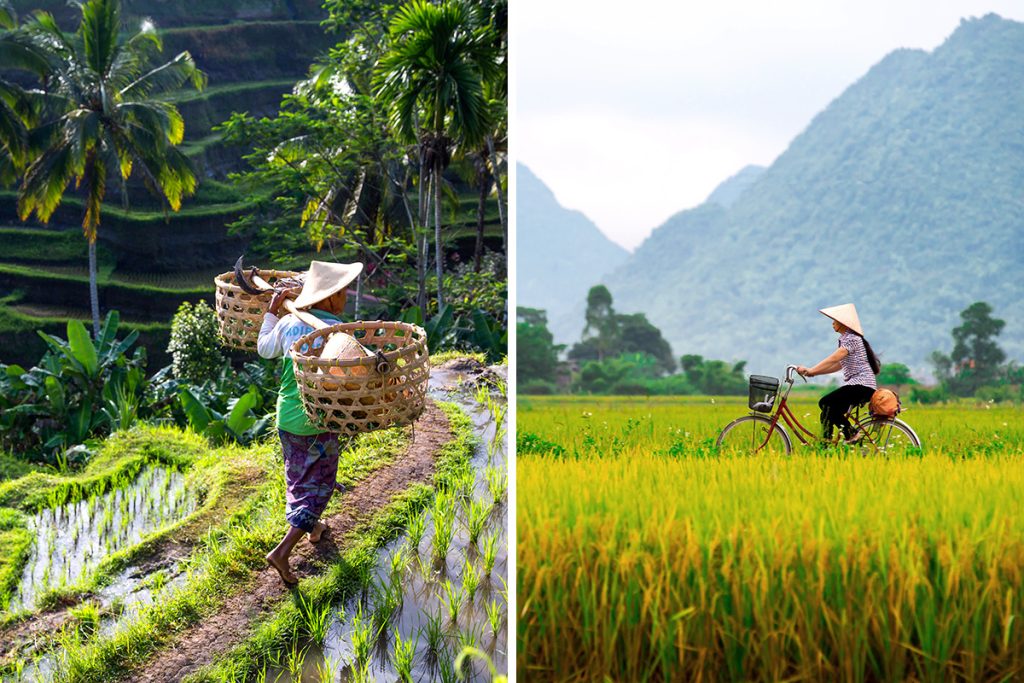You may find yourself torn between the allure of Laos’ untouched landscapes and Vietnam’s bustling cities. Both countries offer unique experiences that captivate your senses and expand your understanding of the world. So, if you’re stuck on where to go, buckle up! We’re about to embark on a journey that compares these two fascinating places.
History & Culture
When it comes to history and culture, Laos and Vietnam are akin to treasure chests waiting to be unlocked. The historical richness of each nation tells a different story but, at the same time, shares many similarities.
Laos boasts a history that’s steeped in spiritualism and folklore. The country remained relatively isolated for centuries, allowing its ancient traditions to flourish. In contrast, Vietnam has a more complex historical background, colored by various invasions, colonial rule, and a notable wartime period.
While Laos provides a serene, spiritual backdrop, Vietnam serves as a dynamic canvas showcasing resilience and cultural evolution.
These nations share the influence of Buddhism, but their interpretations differ. In Laos, Buddhism permeates every aspect of life, from architecture to daily rituals. Vietnam, on the other hand, has a more diverse religious landscape, incorporating elements of Confucianism and Taoism alongside Buddhism.
Furthermore, traditional arts play a significant role in both countries. In Laos, you’ll find an emphasis on textile arts, specifically intricate weaving. Vietnam takes pride in its folk music and theater, especially the unique water puppetry shows that are a must-see.
To sum up, both Laos and Vietnam offer rich cultural experiences but in very different flavors. Laos gives you a peaceful journey through a simpler, spiritual past, while Vietnam offers a multi-layered history that reflects its diverse influences. So, the question remains: Are you in search of spiritual solitude or a dynamic, evolving culture? Your answer could guide your choice between these two captivating destinations.
Attractions & Activities
If you’re an adventurer at heart, both Laos and Vietnam have incredible offerings that will quench your thirst for discovery. Whether it’s riding on the back of an elephant in Laos or trekking through Vietnam’s terraced rice fields, your options are varied and abundant. Let’s delve into what makes each of these countries a hotspot for attractions and activities.
In Laos, a popular choice for many is to explore the mystical Plain of Jars—a megalithic archaeological landscape scattered with large stone jars of unknown origin. For the nature enthusiast, the rugged terrains of the northern regions offer thrilling trekking opportunities.
Don’t forget to take a slow boat cruise down the Mekong River, a peaceful yet exciting way to see the countryside.
Vietnam, on the other hand, offers an array of activities centered around its dramatic landscapes. The iconic Ha Long Bay is a haven for boat cruises among towering limestone pillars.
For those interested in history, a visit to the Cu Chi Tunnels provides a sobering look at the ingenuity of wartime strategies. And for the outdoorsy types, the terraced rice fields of Sapa offer an incredible trekking experience that’s hard to beat.
While both countries offer nature-based activities, they differ in their type and scale. Laos focuses on smaller, intimate experiences deeply connected to its local traditions. Vietnam, meanwhile, offers grander, more visually arresting sights that are often popular tourist destinations.
In summary, Laos provides you with an experience that is intimate, deeply traditional, and spiritually enriching. Vietnam presents you with a scale that’s grander and more iconic, closely connected to its complex history and stunning landscapes. So, will it be the tranquility of a Mekong River cruise or the awe-inspiring views of Ha Long Bay that captivate you?
Beaches
Ahh, the beaches! If you’re a fan of sandy shores and crystal-clear waters, both Laos and Vietnam have something to offer. But how do they stack up against each other? Let’s find out.
Laos is landlocked, meaning you won’t find traditional beaches here. However, the country compensates with its riverbanks.
Take, for example, the Four Thousand Islands in the Mekong River. The sandy shores offer a unique beach-like experience, where you can sunbathe and enjoy water activities. The longest of these ‘river beaches’ stretches for approximately 3 miles (about 4.8 kilometers).
Vietnam’s coastline is a whole different story. Stretching over 2,000 miles (around 3,218 kilometers), the country has a plethora of beaches. Phu Quoc Island is renowned for its white sands and turquoise waters, while Da Nang offers more rugged and windswept landscapes.
What sets the two apart are not just the landscapes but also the types of activities you can indulge in. In Laos, it’s more about enjoying a peaceful moment by the water, perhaps with a book in hand. Vietnam offers a multitude of water sports, from paddleboarding to jet-skiing, thanks to its expansive coastline.
In conclusion, Laos and Vietnam offer unique beach experiences. Laos focuses on peaceful riverbank relaxation, while Vietnam brings an array of options for those looking to add some excitement to their beach visit. So, are you leaning towards the serene calmness of a Laotian riverbank, or does the expansive variety of Vietnam’s coastlines call to you?
Eating, Drinking & Nightlife
When it comes to satiating your gastronomic desires or quenching your thirst for fun, Laos and Vietnam have got you covered. The question is: Which destination caters more to your taste buds and social inclinations? Let’s dig into the flavors and vibes of these two countries.
In Laos, the food scene is a culinary adventure rooted in simple yet flavorful dishes. Think sticky rice, fresh vegetables, and lots of herbs. The local Laotian beer complements the food quite well, offering a refreshing balance to the local spices. On the drinking side, don’t miss out on trying “Lao-Lao,” a traditional rice whiskey that’s incredibly popular.
Vietnam takes its cuisine to another level, with an array of options ranging from the famous Pho to the scrumptious Bánh Mì sandwiches. Vietnamese coffee, brewed with a drip filter, is a must-try and pairs excellently with the local cuisine. When it comes to drinks, Bia Hoi, a freshly brewed beer, provides a unique Vietnamese experience.
Switching gears to nightlife, Laos offers a more subdued experience. Expect small bars and cafes where you can enjoy a quiet evening. However, the night markets in cities like Luang Prabang keep things lively, offering local crafts and snacks until late hours.
Vietnam, conversely, is bustling when the sun goes down. From rooftop bars in Ho Chi Minh City to karaoke parlors in Hanoi, there’s something for every night owl. The country is renowned for its vibrant street life, which continues well into the night.
In summary, Laos offers a humble yet flavorful culinary experience, accompanied by a calm and intimate nightlife. Vietnam dishes out an eclectic range of food and drinks, topped off with a more dynamic and varied night scene. What will it be for you? A laid-back evening in a Laotian café or a lively night in the streets of Vietnam?
Shopping
Whether you’re hunting for unique souvenirs or just want to indulge in some retail therapy, both Laos and Vietnam have something intriguing to offer. What should you expect when it comes to shopping in these two countries?
Laos specializes in handmade crafts, particularly textiles. In the markets of Vientiane or Luang Prabang, you can find intricately woven silk and cotton fabrics. The country is also known for its beautiful silver jewelry, often crafted by local artisans. It’s a great place to buy unique, high-quality items directly from the makers.
Vietnam offers a broader range of shopping experiences. In Hanoi, you can explore ancient streets dedicated to specific crafts, like Hang Bac for silver or Hang Gai for silk. Ho Chi Minh City provides a more modern shopping experience with malls like Vincom Center, where international and local brands co-exist.
While both countries offer textile items, the styles and materials are quite different. Vietnamese silk, for instance, is often brighter and more patterned, whereas Laotian textiles tend to use more earthy tones and intricate weaving.
To sum it up, Laos offers an intimate shopping experience focused on handmade, artisanal products. Vietnam provides a vast array of options, from traditional crafts to modern retail spaces. So, are you keen on handcrafted Laotian textiles or do the bustling markets of Vietnam excite you more?
Accommodation
Finding the right place to lay your head is a critical part of any journey. Laos and Vietnam, both rich in culture and natural beauty, offer a range of accommodation options that cater to various tastes and budgets. Let’s explore what you can expect in terms of lodging in these destinations.
In Laos, you’ll find plenty of budget-friendly guesthouses, often run by local families. These offer a more intimate experience, complete with home-cooked meals and warm hospitality. For a more upscale experience, luxury resorts near scenic spots like the Mekong River or in cultural hubs like Luang Prabang are also available.
Vietnam boasts a wider variety of options, from budget hostels in backpacker districts to world-class luxury hotels. Cities like Hanoi and Ho Chi Minh City offer stylish boutique hotels situated near main attractions, providing both convenience and comfort.
One key difference lies in the amenities offered. Vietnamese hotels often come with more modern conveniences, such as Wi-Fi, air conditioning, and in-house restaurants. In Laos, the focus is more on the experience and less on creature comforts, although Wi-Fi and basic amenities are generally available.
To summarize, if you’re looking for a more traditional, close-to-the-land experience, Laos offers cozy guesthouses and intimate resorts. If modern amenities and a broad range of options appeal to you, Vietnam is your go-to. Where do you see yourself relaxing after a long day of exploration?
Family-Friendliness & Children’s Activities
Taking a family trip? It’s crucial to consider how kid-friendly your destination will be. Laos and Vietnam have distinct features when it comes to family-friendliness and children’s activities. Here’s the scoop.
Laos is generally less crowded and offers a relaxed pace, making it an excellent choice for families who prefer quieter holidays. Children can engage in nature walks, animal spotting, and even some easy trekking in protected national parks.
Vietnam, on the other hand, is a bustling place with lots of family-friendly activities, especially in larger cities. Interactive museums, cultural shows, and cyclo rides are just a few things that can keep kids entertained. Plus, many hotels in Vietnam offer family rooms and even babysitting services.
When it comes to safety, both countries are generally safe for families, but Vietnam’s more developed infrastructure may provide an extra layer of comfort for some parents.
However, if your kids are the adventurous type, they might find the raw, untouched nature of Laos more exciting, where they can learn about local tribes and their way of living.
In summary, Laos offers a more laid-back, nature-focused family experience. Vietnam provides a blend of educational and entertaining activities for kids, set against a backdrop of a more urban environment. Which environment would your family thrive in?
Getting There & Getting Around
Getting to and navigating through your chosen destination are crucial elements of your travel plans. Laos and Vietnam offer different experiences when it comes to both. Let’s break it down.
To get to Laos, most travelers will likely fly into Wattay International Airport in Vientiane, the capital. The airport is approximately 3 miles (about 4.8 kilometers) from the city center.
For Vietnam, the major international gateways are Tan Son Nhat International Airport in Ho Chi Minh City and Noi Bai International Airport in Hanoi. These airports are roughly 4 miles (about 6.4 kilometers) and 21 miles (about 33.8 kilometers) from their respective city centers.
Within Laos, the primary mode of transportation is by bus or minivan for longer distances. Tuk-tuks and bicycles are popular for getting around in cities and towns. The road network is less developed, and the pace is generally slower.
Vietnam offers more in terms of transportation options. You’ve got buses, trains, and domestic flights connecting major cities. In urban areas, motorcycles, taxis, and even app-based ride services are readily available.
In summary, while Laos provides a more relaxed, slower-paced travel experience, Vietnam offers more efficiency and options, making it easier to get around. Both countries have their own unique transportation flavors; it just depends on what suits your travel style.
Weather
When you’re planning a trip, weather is a key factor that can make or break your vacation. Laos and Vietnam, located in Southeast Asia, have tropical climates but with some differences. Let’s dig into the specifics to help you choose the perfect travel time.
In Laos, the dry season runs from November to April, with temperatures ranging from 60-85°F (15-30°C). The wet season, from May to October, sees higher humidity and temperatures around 75-91°F (24-33°C). November to January is particularly cool, making outdoor activities like trekking more comfortable.
Vietnam has more varied weather due to its elongated shape. In the North, like Hanoi, you’ll find a distinct winter from December to February with temperatures dropping to 50-65°F (10-18°C). The south, such as Ho Chi Minh City, is hot all year round, ranging from 77-95°F (25-35°C).
The central regions of Vietnam, like Da Nang, have their rainy season from September to December. The rainy season in the south runs from May to November, while the north has its wet months from May to September.
Both countries have their fair share of hot and humid days, but Vietnam offers a broader range of weather experiences due to its geography.
To sum up, if you prefer cooler and less humid weather, consider visiting Laos from November to April or Northern Vietnam from December to February. If you love the heat, Southern Vietnam might be more your style.
Safety
Your safety is paramount when you’re miles away from home. Let’s look at what Laos and Vietnam offer in terms of ensuring a secure trip.
In general, Laos is considered safe for tourists, with low crime rates, especially in rural areas. Violent crimes are rare, but petty theft like pickpocketing can occur, particularly in crowded places.
Vietnam is similarly safe in terms of crime rates. Scams targeting tourists are more common, especially in big cities like Hanoi and Ho Chi Minh City, so always be aware of your surroundings.
In terms of health, both countries require caution when consuming street food and tap water. Also, make sure to get vaccinated for tropical diseases like Dengue Fever, prevalent in both countries but more so in the rainy seasons.
To sum it up, both Laos and Vietnam offer relatively safe environments for tourists. The key is always to exercise common sense, be aware of your surroundings, and take necessary health precautions.
Cost
Knowing the costs involved can help you make a more informed decision on your travel destination. So, let’s compare what your wallet should be prepared for in Laos and Vietnam.
In Laos, a decent meal at a local eatery will set you back around 20,000-80,000 Lao Kip (approximately $2.50-$10). Accommodations like guesthouses can range from approximately $50 per night. For transportation, buses between cities usually cost around 60,000-100,000 Lao Kip (approximately $7.50-$12.50).
Vietnam offers a similar budget-friendly experience but with more options. A local meal costs around 50,000-200,000 Vietnamese Dong (approximately $2.50-$10). Hotel rooms average approximately $130 depending on location and amenities. Inter-city trains or buses may cost between 100,000-300,000 Vietnamese Dong (approximately $5-$15).
When it comes to activities, Vietnam generally has more variety, but that often comes at a higher cost. You might spend a bit more on entry fees to museums or historical sites, often ranging from 30,000-150,000 Vietnamese Dong (approximately $1.50-$7.50).
In summary, both Laos and Vietnam are relatively affordable destinations, with Vietnam offering a wider range of options at varying costs. Your choice will ultimately depend on what kind of experience you’re looking for and how flexible your budget is.
Which Is Better – Laos or Vietnam?
Wrapping up a multi-faceted comparison like this isn’t simple. Both Laos and Vietnam bring their own unique flavors to the table, each having distinct draws and occasional drawbacks. Let’s summarize what we’ve discovered in the various sections to help you decide your next destination.
When it comes to History & Culture, Laos offers a laid-back experience, perfect for soaking in its unique traditions and culture. On the other hand, Vietnam provides a more dynamic and diverse cultural landscape, thanks to its long, varied history.
If a calmer, more homogenous experience intrigues you, Laos is the place to be. But if you thrive in a melting pot of cultures and historical eras, Vietnam is your go-to destination.
For Attractions & Activities, Vietnam tends to have a wider range of options, offering something for everyone. Laos has its own charm, best suited for those looking for a relaxed pace with fewer crowds. If you’re an adventure seeker or a history buff, Vietnam’s diverse offerings will likely be more up your alley.
In terms of Beaches, both countries have their own unique coastal paradises, but Vietnam’s extensive coastline gives you a wider range of options. If you’re looking for a lesser-known beach experience, Laos could be your haven.
When it comes to Eating, Drinking, & Nightlife, Vietnam offers a bustling scene with a wider range of food and beverage options. Laos is best for those who prefer quieter, less crowded establishments. If a vibrant nightlife is what you seek, then Vietnam is the place for you.
As for Accommodation, both nations offer a range of options to suit various budgets. Laos leans toward simpler, more traditional lodgings, while Vietnam offers more variety, including luxury options.
Lastly, if you’re traveling with family, both nations offer family-friendly options, but Vietnam has a wider range of activities designed for kids. Laos, on the other hand, is a quieter destination that offers a more relaxed atmosphere, which some families may prefer.
In the end, your ideal destination comes down to your personal preferences. If you’re seeking a more laid-back, less touristy experience with a focus on natural beauty and simpler times, then Laos should be on the top of your list. However, if you’re looking for a dynamic atmosphere with a wide array of activities, cultural sites, and food experiences, Vietnam is your answer. Choose according to what most resonates with you and you can’t go wrong.


